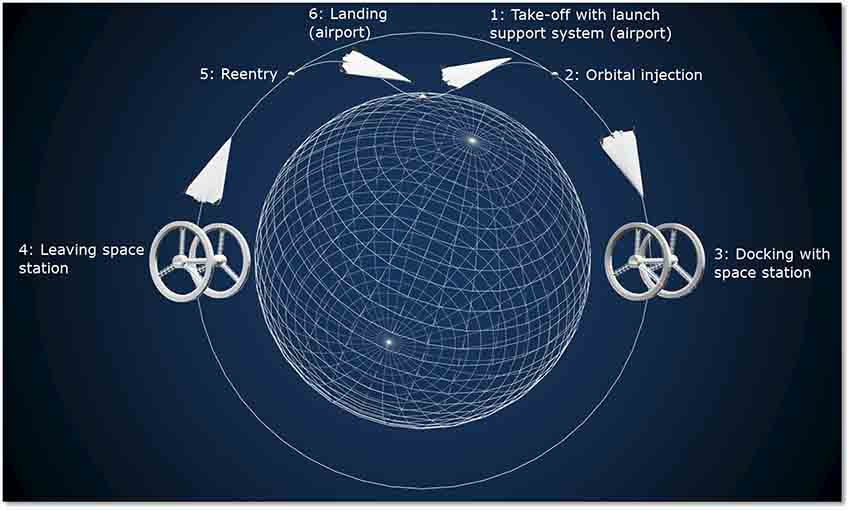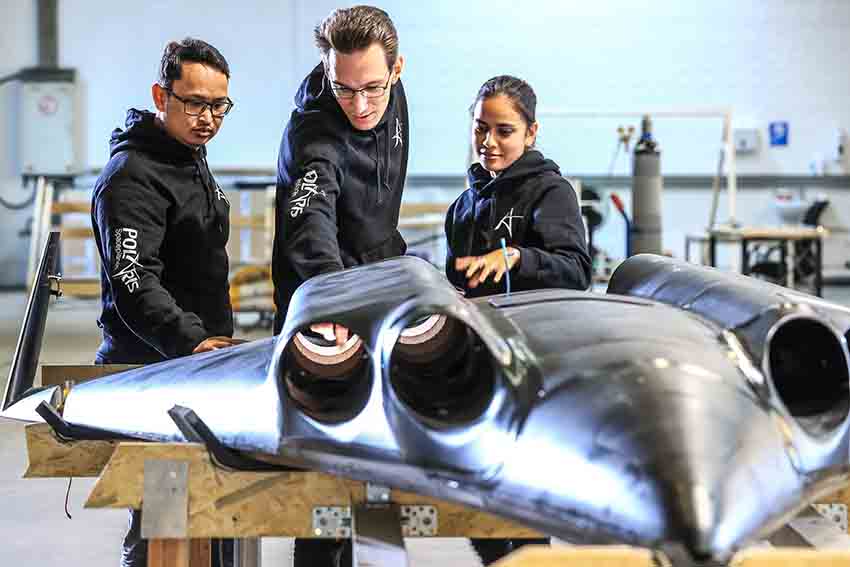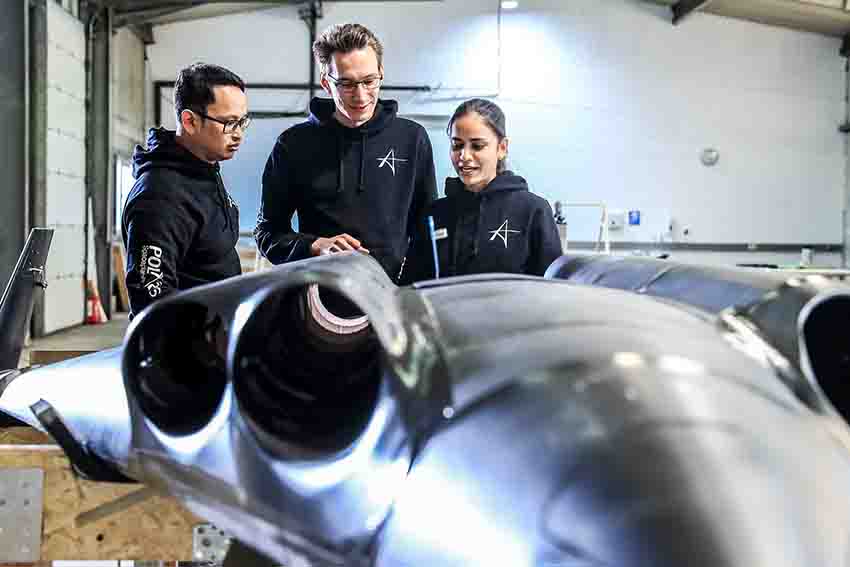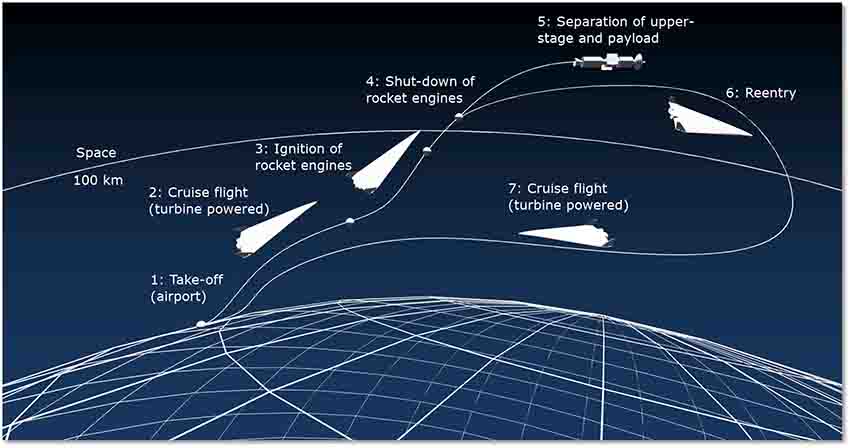POLARIS Spaceplanes is a pioneering enterprise in the field of space travel and has its roots in over 30 years of German and European spaceplane research. As a spin-off of the German Aerospace Center (DLR), it began the development of a novel spaceplane. The concept combines airplane and rocket launch technologies and offers advantageous economic profitability as well as flexible access to regular, cost-effective, and safe space missions from the entire European mainland.
At the core of POLARIS’s activities is the development of the Aurora spaceplane, a system that seamlessly integrates the technologies of aircraft and rocket launchers. This innovation is not just about creating a reusable platform for space and hypersonic transportation; it’s about the next generation of space transportation. Alongside the Aurora spaceplane, POLARIS is also developing commercial hypersonic drones, which serve as versatile tools for aerial reconnaissance and microgravity research applications.
A testament to their expertise in advanced propulsion technologies is their contract with the German Armed Forces to develop a linear aerospike rocket engine. This cutting-edge engine, whose concept origins date back to the 1960s, represents a leap forward in propulsion technology, offering improved performance and efficiency compared against conventional rocket engines. To date, the POLARIS team has conducted 16 hot fire tests, showcasing stable combustion and constant thrust in both chambers, marking significant milestones in their journey towards their spaceplane.

POLARIS’s dedication to pushing the boundaries of aerospace technology is further evidenced by their rigorous testing regime. Having successfully tested five subscale spaceplane demonstrators and conducted over 50 flights, POLARIS has demonstrated a robust capability in creating and testing prototypes and technology demonstrators. These activities are enabled by their dedicated restricted airspace of 260km². The latest addition to their fleet of demonstrators is MIRA, weighing 210kg with a length of 4.3 meters. MIRA has received an official operation license (Beyond Visual Line Of Sight) and a complete insurance coverage. With MIRA, POLARIS is one step closer to its vision of the spaceplane.
Over the past three years, POLARIS has secured three consecutive military contracts, alongside additional contracts from the public space sector. Currently the company is leveraging its demonstrator drones as both internal and external service testbeds for real life in-flight testing. This strategic approach allows POLARIS to continuously refine and enhance their technology while pushing the boundaries of their products capabilities and growing jointly with their regulatory ecosystem.

The horizon looks promising for POLARIS with the introduction of a new spaceplane concept capable of carrying a payload of up to 1t. This spaceplane harnesses a unique combination of rocket and turbine propulsion. The turbine engine is used for takeoff, landing, and transfer flights, while the rocket engine is ignited mid-air, typically over the sea, propelling the spaceplane into space, reaching altitudes exceeding 100 km. This dual propulsion system not only enhances the performance but also broadens the operational capabilities of the spaceplane.
The versatility of POLARIS’s spaceplanes is one of their most defining characteristics. With multi-mission capabilities, these spaceplanes are designed to undertake a variety of tasks, ranging from hypersonic transport to suborbital flights. They are equipped to handle different payloads, making them suitable for satellite launches, scientific research, and commercial space missions. POLARIS envisions offering a broad spectrum of applications, catering to the diverse needs of the burgeoning space industry.

A standout feature of POLARIS’s spaceplanes is their ability to take off and land horizontally on conventional runways. This unique characteristic eliminates the need for specialized space infrastructure, such as dedicated rocket launch sites, leading to significant savings in launch costs. This, coupled with the reusability of the spaceplanes, paves the way for cost-effective and sustainable space transportation. The use of cutting-edge technologies, such as additive manufacturing, and advanced materials further enhances the durability and lifespan of the systems, contributing to the reduction of space access costs and promoting sustainable utilization of space.
In the rapidly growing economic domain of Low Earth Orbit, the demand for cost-efficient, environmentally friendly, and versatile space transportation systems is becoming increasingly imperative. Current solutions, primarily vertical-launching rockets, have nearly reached the technological saturation point of their evolutionary curve, which began around 70-80 years ago. Even recent innovations such as stage reusability and 3D printing will not suffice as long-term solutions. Rockets represent a one-way path to space, but the future of space commerce demands true bi-directional transport solutions for both materials and people, akin to the air transport systems we have on Earth today. Horizontal take-off and landing spaceplanes mark the beginning of a new technological S-curve, already explored by several companies and space agencies, with their fundamental feasibility and cost-effectiveness proven decades ago (compare ESA FESTIP study, 1998). This technology will unlock a truly bi-directional space transportation.

The ongoing assessments of the economic viability of hypersonic applications also play a crucial role in shaping market reception for POLARIS’s offerings. The aerospace and defense market’s potential momentum, coupled with strong revenue outlooks and increased defense budgets, bodes well for companies like POLARIS. Such a financial environment can be particularly beneficial for aerospace startups focusing on innovative technologies. However, this market is not without its challenges. It’s characterized by high competition, technological complexities, extensive legal & export requirements, and significant capital demands, especially as companies transition from the demonstrator phase to operational offerings. But securing a contract from the German Armed Forces for the third consecutive year has bolstered POLARIS’s confidence in forging its path forward.
Looking ahead to early 2024, the team is gearing up for additional hot fire tests with the flight versions of their in-house developed linear aerospike engine. In Q1 2024, this engine will be mounted on MIRA and ignited in-flight, marking a world premiere as no one has ever achieved this feat before. This milestone, led by a dedicated 20 people team from Bremen, is not just an achievement for POLARIS but a historic moment in aerospace. The roadmap doesn’t end here; the development of their sixth and last subscale demonstrator, NOVA, is underway. Equipped with a more powerful linear aerospike engine, NOVA is expected to fly at supersonic speeds, with its maiden flight anticipated in late 2024. In this landscape of innovation and challenges, POLARIS is not merely participating in the aerospace industry; they are actively writing its history.

